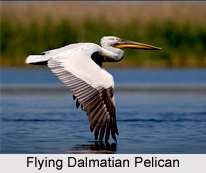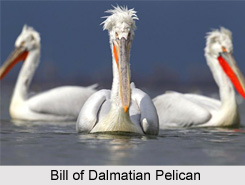 Dalmatian Pelican is an Indian Bird with a scientific name "Pelecanus crispus" and is a massive member of the pelican family.
Dalmatian Pelican is an Indian Bird with a scientific name "Pelecanus crispus" and is a massive member of the pelican family.
Breeding of Dalmatian Pelican
Dalmatian pelican breeds from south-eastern Europe to India and China in swamps and shallow lakes. The nest is a crude heap of vegetation.
Structure of Dalmatian Pelican
Dalmatian pelican is by a slight margin the largest of the pelican species and one of the largest living bird species. It measures 160 to 183 cm in length, 7.25-15 kg in weight and 290-345 cm in wingspan. Its medium weight is around 11.5 kg (25 lb), which makes it perhaps the world`s heaviest flying bird species, although the largest individuals among male bustards and swans may be heavier than the largest individual Dalmatian pelican. More recently, six male Dalmatians were found to average 10.4 kg and four females 8.7 kg around the same average weight as the great white pelican and slightly lighter than mean body masses from other huge birds such as the trumpeter swan (Cygnus buccinator) or Andean condor (Vultur gryphus).
Size of Dalmatian Pelican
Dalmatian pelican broadly overlaps in size but has greater size sexual dimorphism, female great whites can be noticeably smaller than female Dalmatians but male individuals of the two species are essentially of the same size and weight. However, the Dalmatian differs from this other very large species in that it has curly nape feathers, grey legs and silvery-white (rather than pure white) plumage. In winter, adult Dalmatian pelicans go from silvery-grey to a dingier brownish-grey cream colour.
Immature Dalmatian Pelican
The immature Dalmatian pelican are grey and lack the pink facial patch of immature white pelicans. The loose feathers around the forehead of the Dalmatian pelican can form a W-like-shape on the face right above the bill.
Breeding Season of Dalmatian Pelican
In the breeding season it has an orange-red lower mandible and pouch against a yellow upper mandible. In winter, the whole bill is somewhat dull yellow. The bill, at 36 to 45 cm long, is the second largest of any bird, after the Australian pelican (Pelecanus conspicillatus). The bare skin around the eye can vary from yellow to purplish in colour. Among standard measurements, compared to the great white pelican, the Dalmatian`s tarsus is slightly shorter, at 11.6 to 12.2 cm (4.6 to 4.8 in), but its tail and wing chord length are notably larger, at 22 to 24 cm (8.7 to 9.4 in) long and 68 to 80 cm (27 to 31 in), respectively. When the Dalmatian pelican is in flight, unlike other pelicans, its wings are solid greyish-white with black tips. It is an elegant soaring bird. When a whole flock of Dalmatian pelicans is in flight, all its members move in graceful synchrony, their necks held back like a heron`s.
Sounds of Dalmatian Pelican
Dalmatian pelican is often silent, as most pelicans tend to be, although it can be fairly vocal during the mating season, when it may engage in a wide range of guttural, deep vocalisations, including barks, hisses and grunts.
 Concentration of Dalmatian Pelican
Concentration of Dalmatian Pelican
Dalmatian pelican is found in lakes, rivers, deltas and estuaries. Compared to the great white pelican, the Dalmatian is not as tied to lowland areas and will nest in suitable wetlands at many elevations. It is less opportunistic in breeding habitat selection than the great white, usually returning to a traditional breeding site year after year unless it becomes completely unsuitable. During the winter, Dalmatian pelicans usually stay on ice-free lakes in Europe or seasonal lakes in India. They also visit, typically during winter, inshore areas along sheltered coasts for feeding
Migration of Dalmatian Pelican
Dalmatian pelican usually migrates short distances. It is dispersive in Europe, based on feeding opportunities, with most western birds staying through the winter in the Mediterranean region. In the Danube Delta, Dalmatian pelicans arrive in March and leave by the end of August. It is more actively migratory in Asia, where most of the birds that breed in Russia fly down for the winter to the central Middle East, largely around Iran through to the Indian Subcontinent, from Nepal to central India. The pelicans that breed in Mongolia migrate along the east coast of China, including the Hong Kong area.
Feedings of Dalmatian Pelican
Dalmatian pelican feeds almost entirely on fish. Preferred prey species can include common carp (Cyprinus carpio), European perch (Perca fluviatilis), common rudd (Scardinius erythropthalmus), eels, catfish (especially silurids during winter), mullet and northern pike (Esox lucius), the latter having measured up to 50 cm when taken.











